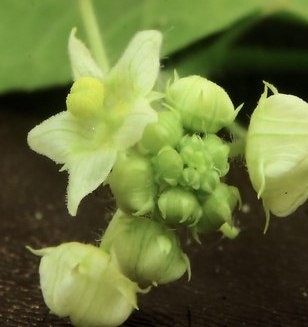Oneseed bur cucumber
(Sicyos australis)

Description
Sicyos angulatus, the oneseed bur cucumber or star-cucumber is an annual vine in the gourd family, Cucurbitaceae, native to eastern North America. The plant forms mats or climbs using tendrils. The leaves are palmately veined and lobed, the flowers are green to yellowish green, and the fruits form clusters of very small pepos. The vine produces long branching annual stems that climb over shrubs and fences or trail across the ground. The stems are hairy, pale green and furrowed. The alternate leaves have three to five palmate lobes and can be 8 in (20 cm) across. The margin is slightly toothed, the upper surface of the blade is usually hairless and the under side has fine hairs, especially on the veins. The petiole is thick and hairy, and about 5 in (13 cm) long. The leaf is deeply indented where it is attached to the petiole. Opposite some of the junctions formed by the petiole and stem, grow branched tendrils, and at others there are flower shoots. The flowers are monoecious, with separate male and female blooms. The male flowers are in long-stemmed racemes. Each flower is about 0.3 in (0.8 cm) wide, with a calyx with five pointed teeth, a whitish, green-veined corolla with five lobes, and a central boss of stamens. The small female flowers are bunched together on a short stalk, each having its ovary enclosed in a spiny, hairy fruit; one seed is produced by each flower. The fruit is about 0.5 in (1.3 cm) long, green at first but becomes brown with age; it is dispersed by animals which come into contact with its bristly surface. S. angulatus is native to Ontario and Quebec in Canada, and the eastern and southern parts of the United States as far west as North Dakota and Texas. It grows in fertile, moist habitats such as floodplain areas, damp grassland, thickets, bushy places, river banks, ditches and field verges. It appreciates disturbed ground. In Europe the oneseed bur cucumber was introduced as a ornamental plant during the 18th century; the first report of its naturalization in Germany dates back to 1835. In Italy was reported in Trentino since 1853. Nowadays Sicyos angulatus is considered an invasive species, quite difficult to control because its seed bank can last in the ground for at least three years after the destruction of the aerial part of the plant. Its infestation can be impressive, covering the pre-existing vegetation with thick and heavy mats.
Taxonomic tree:







